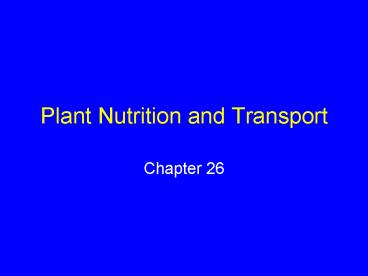Plant Nutrition and Transport - PowerPoint PPT Presentation
1 / 34
Title:
Plant Nutrition and Transport
Description:
Many aspects of plant structure are responses to low ... Loam. Roughly equal proportions of sand, silt, and clay. 10 to 20 percent humus. Soil Horizons ... – PowerPoint PPT presentation
Number of Views:150
Avg rating:3.0/5.0
Title: Plant Nutrition and Transport
1
Plant Nutrition and Transport
- Chapter 26
2
Plant Nutritional Requirements
- Nearly all plants are photoautotrophs
- Require carbon dioxide, water, minerals
- Many aspects of plant structure are responses to
low concentrations of these vital resources in
the environment
3
Macronutrients
- Mineral elements that are required above 0.5
percent of the plants dry weight - Carbon Nitrogen Magnesium
- Hydrogen Potassium Phosphorus
- Oxygen Calcium Sulfur
4
Micronutrients
- Elements that are required in trace amounts for
normal plant growth - Chlorine Zinc
- Iron Copper
- Boron Molybdenum
- Manganese
5
Soil
- Minerals mixed with humus
- Minerals come from weathering of rock
- Humus is decomposing organic material
- Composition of soil varies
- Suitability for plant growth depends largely on
proportions of soil particles
6
Three Soil-Particle Sizes
- Sand
- Largest particles
- Silt
- Medium-sized particles
- Clay
- Finest particles
7
Humus
- Decomposing organic material
- Nutrient rich
- Negatively charged organic acids help humus
attract positively charged minerals - Absorbs water and swells shrinks as it releases
water - Helps to aerate soil
8
Optimal Soil for Plant Growth
- Loam
- Roughly equal proportions of sand, silt, and clay
- 10 to 20 percent humus
9
Soil Horizons
- O horizon - organic litter on surface
- A horizon - topsoil
- B horizon - less organic material, more minerals
- C horizon - no organic material
10
Leaching
- Removal of nutrients from soil by water that
percolates through it - Most pronounced in sandy soils
- Clays are best at holding onto nutrients
11
Root Hairs
- Extensions from the root epidermis
- Greatly increase the surface area available for
absorption
12
Mycorrhiza
- Symbiosis between a young plant root and a fungus
- Fungal filaments may cover root or actually
penetrate it - Fungus absorbs sugars and nitrogen from the plant
- Roots obtain minerals absorbed from soil by
fungus
13
Root Nodules
- Swelling on the roots of some plants
- Contain nitrogen-fixing bacteria
- Bacteria convert nitrogen gas to forms that
plants can use
14
Root Structure Absorption
- Roots of most flowering plants have
- Endodermis - surrounds vascular cylinder
- Exodermis - just below epidermis
- Cells of both layers contain a Casparian strip
- Controls the flow of water and nutrients
15
Inside a Root
exodermis
cortex
newly forming vascular cylinder
abutting walls of endodermal cells
16
Vascular Cylinder
tracheids and vessels in xylem
sieve tubes in phloem
pericycle (one or more cells thick)
endodermis (one cell thick)
17
Casparian Strip
18
Water Use and Loss
- Plants use a small amount of water for metabolism
- Most absorbed water lost to evaporation through
stomata in leaves - Evaporation of water from plant parts is
transpiration
19
Water Transport
- Water moves through xylem
- Xylem cells are tracheids or vessel members
- Both are dead at maturity
vessel member
tracheid
20
Cohesion-Tension Theory of Water Transport
- Transpiration creates negative tensions in xylem
- Tensions extend downward from leaves to roots
- Hydrogen-bonded water molecules are pulled upward
through xylem as continuous columns
21
Transpiration Drives Water Transport
Water evaporates from leaves through stomata
This creates a tension in water column in xylem
22
Replacement Water Is Drawn in through Roots
23
The Role of Hydrogen Bonds
- Hydrogen bonds attract the hydrogen of one water
molecule to the -OH group of another - Hydrogen bonds make water cohesive water
molecules stick together inside the narrow xylem
walls as the molecules are pulled upward
24
Osmosis and Wilting
- Water responds to solute concentrations moves
osmotically into plant cells - When water loss is balanced by osmotically
induced movement inward, plant is erect - If water concentration of soil drops, inward
movement stops, plant wilts
25
Cuticle
- Translucent coating secreted by epidermal cells
- Consists of waxes in cutin
- Allows light to pass though but restricts water
loss
26
Stomata
- Openings across the cuticle and epidermis allow
gases in and out - Guard cells on either side of a stoma open and
close it
27
What Causes Stomata to Open?
- Guard cells contain chloroplasts
- When carbon dioxide available for photosynthesis
drops, potassium ions are transported into guard
cell - Water follows by osmosis, causing increased
turgor pressure - Increased pressure causes shape change, opening
stoma
28
CAM Plants
- Most plants are C3 or C4 plants
- Stomata open during day and photosynthesis
proceeds - CAM plants are better at water conservation
- Stomata open at night and carbon dioxide is fixed
- Next day, stomata remain closed while carbon
dioxide is used
29
Phloem
- Carry organic compounds
- Conducting tubes are sieve tubes
- Consist of living sieve-tube members
- Companion cells
- Lie next to sieve tubes
- A type of parenchyma
- Help load organic compounds into sieve tubes
30
Transport through Phloem
sieve plate
companion cell
sieve tube member
- Driven by pressure gradients
- Companion cells supply energy to start process
31
TransportableOrganic Compounds
- Carbohydrates are stored as starches
- Starches, proteins, and fats are too large or
insoluble for transport - Cells break them down to smaller molecules for
transport - Sucrose is main carbohydrate transported
32
Translocation
33
Loading at Source
- Small soluble organic compounds loaded into phloem
34
Unloading at a Sink
- Region where compounds are being stored or used
- Solutes are unloaded into sink cells and water
follows
Section from a root































